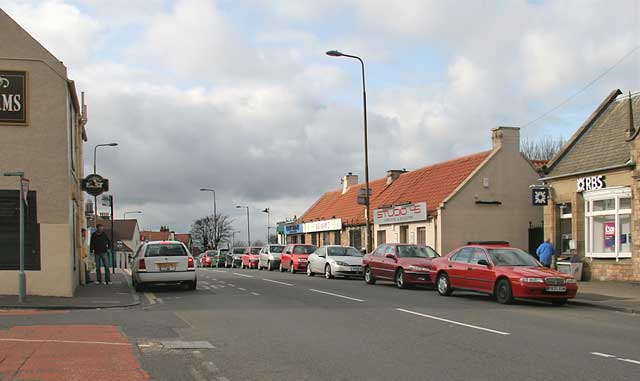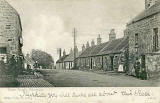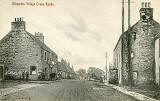|
Albany Series Postcard Gilmerton Looking NW up Drum Street |
Gilmerton Drum Street - Early 1900s
© Reproduced with acknowledgement to Eric Nisbet, Barnton, Edinburgh, formerly Gilmerton, Edinburgh.
Gilmerton Drum Street - 2008
© Copyright: Peter Stubbs - please contact peter.stubbs@edinphoto.org.uk Photo taken: April 3, 2008
|
Gilmerton - Early 1900s |
||
|
1. Albany Series Postcard Gilmerton |
|
Postcard posted 1906 Thank you to Eric Nisbet for providing the image above from a postcard. The postcard was published by Albany (No. 1465, a96/147). The card was posted to an address in Northumberland on May 23, 1906. The message on the front of the card reads: "I suppose you will know all about this place." |
|
Zoom-in The whole of this picture or parts of it can be enlarged to give more detail. Please click on one of the thumbnail images to see the enlargements. |
|
2. Location |
|
Thank you to Forbes Wilson who wrote: "I instantly recognised the location of your two Gilmerton Village postcards. Both were taken on Drum Street looking north to the present day junction formed by Newtoft Street, Ferniehill Drive and Gilmerton Road. The exit road on the left (with the group on the corner) is Ravenscroft Street. About 100 metres up this road is the scout hall where the 143rd scout group used to meet every Thursday evening - good memories. Forbes Wilson, near Guildford, Surrey, England: March 23, 2007 |
|
This is the other Gilmerton postcard that Forbes refers to: |
|
2008 The location (including the trees!) can still be recognised from the 2008 photo. The large building on the left has become the Mechanic Arms public house. The tall building on the right in the postcard appears to have been demolished and replaced by a low building with Royal Bank of Scotland carved in the stonework above the door. This is still operating as a branch of the Royal Bank of Scotland. |
|
3. Gilmerton History |
|
Thank you to Archie Young, Moredun, Edinburgh, who is currently working on the Greater Liberton Heritage Project, for sending the following information about Gilmerton. Archie wrote: |
|
On the Left ... "The Pub on the left in this photo is now the Mechanic Arms. It's a very old Pub and was a staging post in days of old when they had the stage coaches. Next to the Pub the three cottages no longer stand. They were pulled down a few years ago. Down past those cottages, there are another two. The first is now a veterinary surgery belonging to Mr Pennman of Portobello. The next has the famous Cove." |
|
On the Right ... "The building on the right, looks like 'Mission Saloon', or it may have been two separate units, one a Mission, the other a Saloon. It may well have been a Food Mission (as these times were hard) or a Faith Mission." |
|
Please click on the thumbnail image below to read more about the 'Saloon' sign on the right hand side of the photo above. Archie added: |
|
Bank "The Royal Bank of Scotland is indeed on this site, and set further back." |
|
Pubs and Breweries "At one time there were supposed to have been seven Pubs in Gilmerton, and twelve Breweries. In those days, a house could well have been a Pub where the owner sold drink of some sort. If that owner made his own beer then it became known as a Brewery. These houses would be open any time including the Sabbath (Sunday) which was frowned upon by the Church." |
|
Early History "The earliest records about Gilmerton date back to the 12th century. The original name was Gaelic 'Gille-Moire'. Then there was 'Gilmour's Tun' then 'Gilmer-Tun' meaning a farm place. However, Gilmerton really came into the light for its coal or 'Black Stanes' in the 15th century. In the mid 1800s Gilmerton had the deepest recorded mines in Scotland. Later on, around the 19th century it became famous for its lime workings. It was also famous for its 'yellow sand' that was used for sprinkling on the floors and cellars of large houses throughout Edinburgh and beyond. In the city, the carters would yell out: 'Yellow Sand'. Within the area of Gilmerton there were flour mills and grain mills, Hyvots Mill, Stennis (Stenhouse) Mill and Moredun Mill which became a shoe factory owned by the Carr family. It's now the British Geological Survey." |
|
Archie Young: Moredun, Edinburgh: April 5, 2008. |





